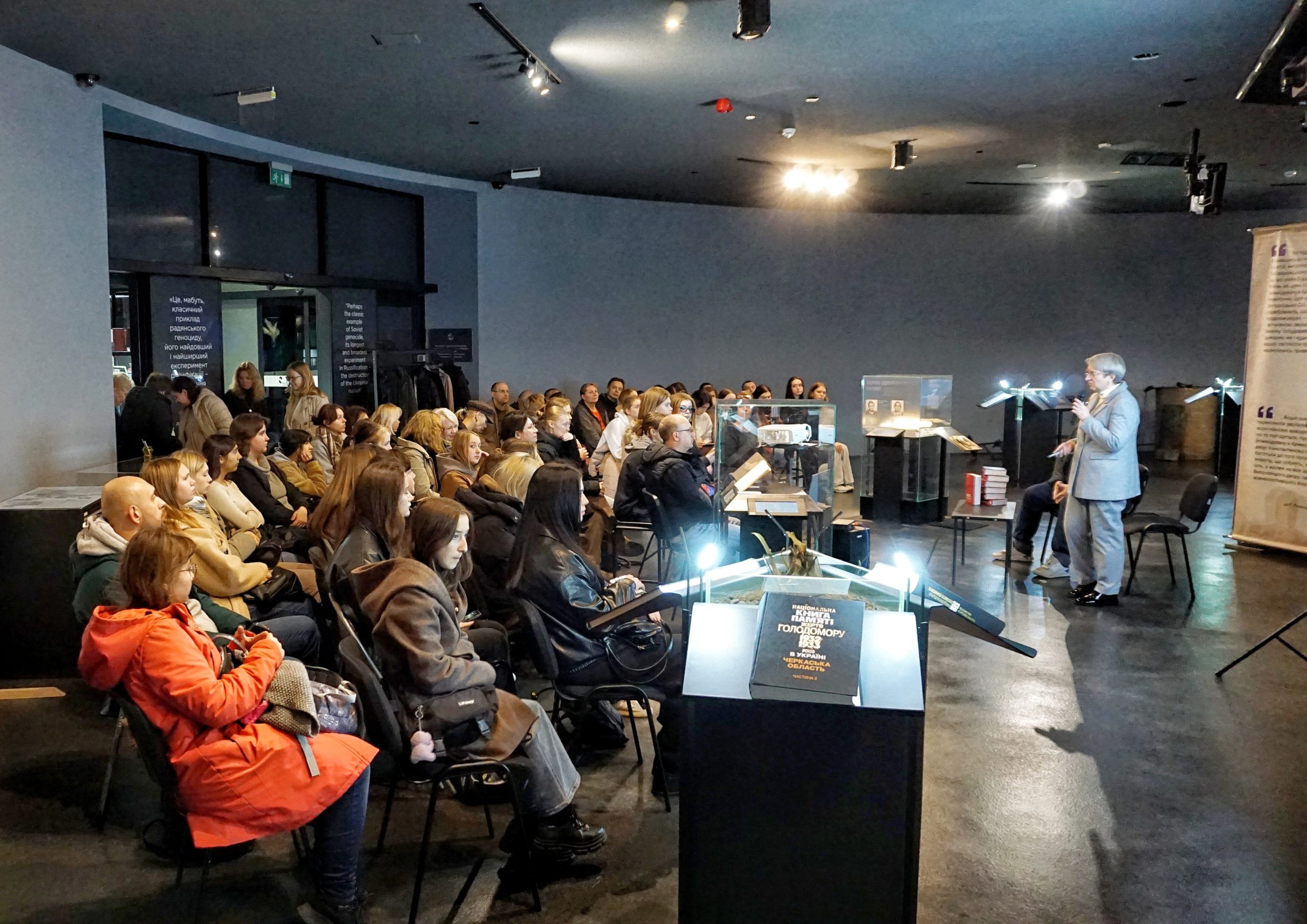Presentation of the collection “Prerequisites for the Holodomor: Collectivisation and Dekulakisation in the Dnipropetrovsk Region”
On 23 October, the Holodomor Museum presented “The Prerequisites of the Holodomor: Collectivisation and Dekulakisation in the Dnipropetrovsk Region (December 1929 – September 1931)”. As the event moderator Andrii Ivanets emphasised, this is already the third collection of documents on the Holodomor in the Dnipropetrovsk region and the events that preceded it, compiled by the leading research associate of our museum’s Holodomor and Mass Man-Made Famines Research Department, Professor Nataliia Romanets, Doctor of Historical Sciences.
The new collection includes 160 documents that the historian found in the archives. Some of them were classified as “secret” for a long time and were published for the first time after being declassified.
Researching the background to Stalin’s most brutal crime, Nataliia Romanets categorised the documents according to the following themes:
- the activities of regional leaders during the mass collectivisation;
- the main stages and methods of mass collectivisation;
- the dekulakisation and deportation of peasants during 1930-1931;
- the social and political mood of the residents of the Dnipropetrovsk region;
- forms of peasant resistance to forced collectivisation and dekulakisation.
“I needed to reconstruct, in as much detail as possible, how the complete collectivisation and dekulakisation occurred in the Dnipropetrovsk and Kryvyi Rih districts. I didn’t want to just give a general picture of those events and statistics, but rather show how it actually happened, how the peasants reacted, how people tried to survive in those conditions, and how they tried to resist. It was also important for me to show how the deportation took place and the conditions people found themselves in when they were sent away. After all, many of those who were dekulakised saw deportation as an opportunity to survive, thinking that they would somehow be able to adapt in their new place,” says Nataliia Romanets.
The historian emphasises that she was particularly struck by the story of a peasant named Cherep from the village of Dovhalivka in the Nikopol district: “Just think about it: on 22 January, a man was dekulakised, thrown out onto the street, and all his property was taken away. To cook food, they left him a galvanised bucket, which cannot be used for cooking. The children were poisoned. This man, who had everything, then walked around the village and asked for at least some kind of pot to cook food for his children. And the deportation took place at the end of February. That means people had to survive somehow for a month.”
Ms Natalia also emphasises that the documents she found and published contain many names: those who dekulakised and those who were dekulakised, executioners and victims. The researcher also set herself the task of ‘humanising the statistics, showing that the victims of Stalin’s terror by famine were not abstract millions of Ukrainians, but real people with names, places of residence, and pasts, but who were deprived of their future.”
Explaining why the book was titled “The Prerequisites of the Holodomor”, Nataliia Romanets noted: “The total collectivisation carried out by the authorities from December 1929 to August 1931 in the Dnipropetrovsk region caused major disruption to agricultural production. The number of livestock decreased, production in the collective farms was not properly organised, and, as a result, already in 1930, there were major problems with the harvesting campaign and with the transport of grain to collection points, which could not accept the large harvest of 1930. However, the authorities were convinced that we had, as the propaganda said, “grain factories” that would produce as much grain as we needed. They did not take into account the real situation in the agricultural sector after the complete collectivisation. And if we talk about the grain procurement campaigns of 1931-1933, they were conducted in an agricultural sector that had been virtually destroyed by collectivisation, and the confiscation of grain in those conditions became a direct precursor to the Holodomor. But the authorities did not want to notice or acknowledge the real situation. Although they were fully aware of it.”
The head of the Ukrainian Institute of National Remembrance, Oleksandr Alfiorov, congratulated Nataliia Romanets on the publication of her latest book and emphasised the importance of such research:
I clearly remember how, in the 1990s, while I was in school, this topic was only the beginning to be explored. Many people believed that famine was a widespread issue. However, today, thanks to consistent efforts based on scientific concepts, foundations, and methodologies, we can understand that it was the result of an intentional policy aimed at an entire nation. The Holodomor was a strategy devised by specific individuals in a particular location, Moscow, specifically the Kremlin. It was here that they developed a method to break the spirit of the Ukrainians. I am very grateful to the scholars who are researching this topic. Their work is challenging, as it involves touching the raw nerves of society, especially when dealing with memories of relatives, neighbours, and loved ones. My family survived the Holodomor thanks to silver spoons, but many others did not have that option.
Dear friends, we would like to remind you that the collection “Prerequisites of the Holodomor: Collectivisation and Dekulakisation in the Dnipropetrovsk Region (December 1929 – September 1931)” is available for purchase at our museum’s ticket office. Alternatively, you can request delivery by emailing us at [email protected].
